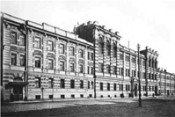
Women’s higher education institution (Bestuzhev Courses) opened in St. Petersburg
September 20 (October 2), 1878 in St. Petersburg, as a private school, opened a higher education institution for women (Bestuzhev courses). Among its founders were well-known public figures and scholars, Professor of St. Petersburg University A. N. Beketov, D. I. Mendeleev, I. M. Sechenov, A. M. Butlerov, K. N. Bestuzhev-Rumin, as well as women movement leaders – A. P. Filosofova, N. V. Stasova, O. A. Mordvinova, V. P. Tarnovskaya, N. A. Belozerskaya, E. I. Konradi, M. A. Menzhinskaya.
During the struggle for women's access to higher education in 1850-1870s a variety of community organizations, public courses and lectures opened in St. Petersburg. Ministerial officials gave their authorization for all these initiatives with great reluctance, there were no government subsidies and the graduates received no rights. Back in 1850's there were first auditors in St. Petersburg University. In 1869 the first women’s higher education institution – Alarchinsky courses - opened in St. Petersburg and Lubyanka courses - in Moscow. In 1870 in St. Petersburg Vladimir courses were organized - public lectures for men and women. In 1872, for the education of scientists midwives the courses under the Medico-Surgical Academy opened, renamed into the Higher medical courses in 1876.
Finally, on September 20 (October 2) 1878 in St. Petersburg in the building of the Alexander High School on Gorokhovaya street, took place the grand opening of the first higher educational institution for women in Russia - the Higher Courses for Women. Historian K. N. Bestuzhev-Rumin was appointed the first director of the courses; in his honor the courses were unofficially called "Bestuzhev’s”.
As a private institution, the courses received only 3 thousand rubles a year as a grant from the Ministry of Education and the St. Petersburg City Council. They were funded mainly by a specially created "Society for funding the higher courses for Women." The main income of the society was the tuition fee. Members of the Society, who worked at courses, were considered to be public figures and did not receive any salary.
In 1885, for the Higher Courses for Women at the 10th Line of Vasilievsky Island was built its own edifice designed by academician of architecture A. F. Krasowski, with the participation of V. R. Kurzanov. Later the building started to grow owing to the wings and bodies added to the main building.
Since 1889, due to the retirement of K. N. Bestuzhev-Rumin, the courses began to be called the St. Petersburg Higher Courses for Women (their informal name, Bestuzhev’s, remained unchanged though.)
The courses included three faculties: History and Philology, Physics and Mathematics (originally divided into physics and mathematics and special mathematics departments) and law (opened in 1906).
After the 1905 revolution the courses received autonomy. Council of professors was allowed to elect the director from its environment. The learning process was also reorganized. At Bestuzhev courses a new system was introduced, it was called the subject system and allowed students to choose optional lecture courses, and teachers - to diversify and expand the system of practical training and courses.
In 1910, the State Council recognized the St. Petersburg Higher Women's (Bestuzhev) courses a higher education institution providing education equal to the university’s one. Certificate of graduation of the courses was equated to the university degree.
The higher women's courses had lasted for 40 years, from 1878 to 1918. And in 1918, the courses, as the Third Petrograd University, were merged with the First Petrograd University.
On the whole there were about 6 thousand 933 students who graduated from the Higher Women (Bestuzhev) courses. The greatest number of students graduated from the historical-philological faculty - 4 311; 2 385 students graduated from Physics and Mathematics Department and 237 students – from the Department of Law. The bulk of the graduates devoted themselves to teaching, many of them worked in libraries and other educational institutions. Among those who graduated from Bestuzhev courses there were many outstanding scientists, writers, leaders of social movements. Bestuzhev courses went down in history of the Russian education as the first higher education institution for women of a university type.
Lit.: Высшие Бестужевские курсы [Электронный ресурс] // Женщины Санкт-Петербурга. 2000-2005; Высшие женские (Бестужевские) курсы: Библиографический указатель. М., 1966; Санкт-Петербургские высшие женские (Бестужевские) курсы, 1878-1918. Л., 1973; Федосова Э. П. Бестужевские курсы — первый женский университет в России (1878-1918 гг.). М., 1980; Юридический факультет Высших Женских (Бестужевских) курсов [Электронный ресурс] // Юридический факультет СПбГУ. Б. д. URL: http://law.spbu.ru/testexlib/testexlibra/c720d3fe-80c0-4f0e-b226-b10f5b5d1e9a.aspx.
Based on the Presidential Library’s materials:
Virtual tour of the Bestuzhev courses Library (with narration);
Virtual tour of the Bestuzhev courses Library;
Кобеко Д. Ф. К родословной рода Бестужевых-Рюминых. СПб., 1889.

